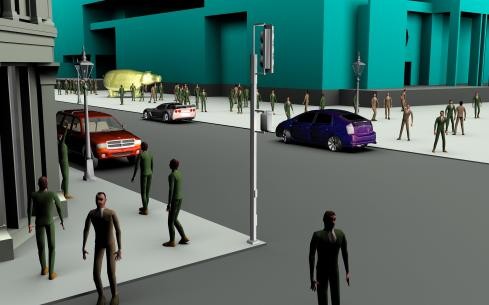Exploring the dynamics of individual pedestrian and crowd behavior in dense urban settings: a computational approach
Dr. Paul Torrens is researching the dynamics of pedestrian and crowd behavior. The choreography of pedestrian and crowd movement is important to many domains of interest, particularly in the geographical sciences. We often require computer models of movement to engineer transportation infrastructure, to assess architecture and urban design plans, to evaluate emergency egress routes, to site retail facilities, or even to deliver services over mobile telecommunications systems.
Recently, agent-based models have become a popular tool for simulating movement. The fidelity of agent-based movement models is naturally most acute when the models driving their synthetic characters reproduce the geography of their behaviors appropriately: by placing people in the right places, at the right times, doing the right things, in the right contexts. However, most simulation environments for moving agent pedestrians rely on simple, abstract physics-based heuristics to drive synthetic characters and they focus on generating plausible coarse-grained movement patterns, which might not always map to real-world pedestrian behavior. Moreover, existing approaches often produce serious mechanical artifacts in simulation.
In this project, we are developing innovative methods for constructing agent-based models of movement that better characterize how people actually behave in the real world, primarily by catering to the polyspatial behavior of mobile humans. These methods describe geographies of human behavior at the scale of the body, all the way up to the space-time rhythm of large cities. We are also developing new technologies to allow people to experiment with the models in new, exciting ways, using immersive computer graphics, motion capture, gaming, and animation. The result is a more useful simulation architecture that can be applied to a wider range of explorative scenarios and that fundamentally expands the range of questions that can be posed (by students, researchers, policy-makers, the public) in simulation. This work is funded by grants from the National Science Foundation through it Geography and Spatial Sciences; Methodology, Measurement, and Statistics; and Dynamical Systems divisions.
More details are available at http://www.geosimulation.org/
Published on Tue, 01/31/2012 - 16:03


